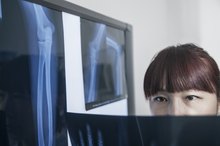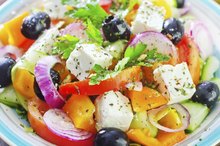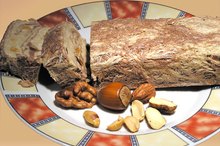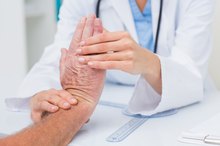A Holistic Diet for Avascular Necrosis
Avascular necrosis, also known as osteonecrosis or asceptic necrosis, is defined as bone death due to loss of blood supply to the affected area. It can be caused by long-term use of steroids, excessive alcohol consumption and illnesses such as sickle cell anemia. In addition to conventional medical treatment, proper nutrition is important when suffering from this type of bone deterioration. Consult your medical doctor for a specific treatment plan, which may include dietary modification and supplementation.
Alcohol
One of the main prevention methods of avascular necrosis listed by the the National Institutes of Health is avoiding excessive alcohol consumption and is, therefore, one of the most important things you can do for your diet once diagnosed with the disease 14. Conventional treatments for avascular necrosis also typically include exercise, rest and surgery, such as bone grafting and joint replacement. However, it is also crucial to avoid substances which can cause bone loss. The main culprits are alcohol, excessive sodium and stimulants such as caffeine and nicotine.
- One of the main prevention methods of avascular necrosis listed by the the National Institutes of Health is avoiding excessive alcohol consumption and is, therefore, one of the most important things you can do for your diet once diagnosed with the disease 1.
Protein
Top Bone Diseases
Learn More
Protein consumption has become a controversial subject with some fad diets. Some programs restrict or eliminate protein foods such as meat, eggs and dairy. Others advocate eating primarily protein foods. However, neither method is truly balanced, or holistic. According to Dr. Jane Higdon of the Linus Pauling Institute, both excessive consumption and lack of dietary protein can lead to bone loss. Deterioration of the bone is one of the main effects of avascular necrosis. Instead of following extremes, Dr. Higdon suggests adults get adequate amounts of protein in their diets. The U.S. Department of Agriculture's guidelines state that men and women should consume between 5 1/2 to 6 1/2 oz. of protein each day. This includes meat, eggs, fish, nuts, seeds, dried beans and other legumes.include:
- This includes meat
- eggs
- fish
- nuts
- seeds
- dried beans
- other legumes
- Protein consumption has become a controversial subject with some fad diets.
- According to Dr. Jane Higdon of the Linus Pauling Institute, both excessive consumption and lack of dietary protein can lead to bone loss.
Calcium and Vitamin D
Calcium and vitamin D work together to build healthy bones 4. Although these nutrients alone do not specifically treat avascular necrosis, they are important in preserving bone mass. Foods rich in these essential nutrients include dairy products like milk, cheese and yogurt, as well as fortified cereals, orange juice and soy milk. The National Institutes of Health notes that most people do not get enough vitamin D or calcium to maintain healthy bones 14. Adults require at least 1,000 mg of calcium each day, and 1,200 mg if they are 70 years or older. They also require at least 600 IU of vitamin D daily, or 800 IU if over the age of 70.
Other Nutrients
Bone Eating Diseases
Learn More
Because vitamins and minerals work together in the body to ensure all systems function properly, it is important to eat a variety of foods, especially whole grains, fresh fruits and vegetables each day. According to the USDA adults require 6 to 8 oz. of grains daily, half of which should be whole grains. They also require 1 1/2 to 2 cups of fruit and 2 1/2 to 3 cups of vegetables each day. Typically, foods rich in color are also high in vitamins.
- Because vitamins and minerals work together in the body to ensure all systems function properly, it is important to eat a variety of foods, especially whole grains, fresh fruits and vegetables each day.
Related Articles
References
Writer Bio
A professional writer since 2008, Tracey Planinz writes articles on natural health, nutrition and fitness. She holds a doctorate and two professional certifications in her field, and continues to develop her education with additional classes and seminars. She has provided natural health consultations and private fitness instruction for clients in her local community.








